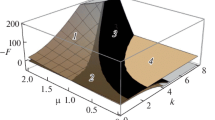Abstract
The stability of a surface-charged cylindrical jet in a longitudinal uniform electric field with respect to capillary pertubations is investigated in the linear approximation. The evolution of both axisymmetric and azimuthal-periodic perturbations is analyzed. In the latter case the first two modes among the azimuthal wavenumbers — bending and Bohr — are considered. Axisymmetric and bending instabilities lead to the transverse disintegration of the jet into individual drops and the Bohr mode to the longitudinal separation of the input jet into two parts. It is found that the axisymmetric and bending instabilities, respectively, can be completely suppressed and significantly attenuated by means of an external longitudinal field. In this case the role of the Bohr mode becomes more important leading under certain conditions to longitudinal longwave jet splitting. Events which can be interpreted as manifestations of longitudinal partition of the jet (dumbbell-like cross-section, branching nodes) are observed in experiments with evaporating polymer-solution microjets.
Similar content being viewed by others
References
A. S. Ginevskii, “Features of capillary disintegration of charged dielectric jets,” in:Proceedings of Moscow Power-Engineering Institute, No. 119 [in Russian], Moscow (1986), P. 18.
G. A. Glonti, “Theory of stability of liquid jets in an electric field,”Zh. Eksp. Teor. Fiz.,34, 1329 (1958).
D. A. Saville, “Stability of electrically charged viscous cylinders,”Phys. Fluids,14, 1095 (1971).
I. E. Tamm,Fundamentals of Electricity Theory [in Russian], Nauka, Moscow (1976).
A. G. Kulikovskii and G. A. Lyubimov,Magneto-Hydrodynamics, Addison-Wesley, Reading, Mass. (1965).
V. Ya. Shkadov, “Some methods and problems of the theory of hydrodynamic stability,” in:Proceedings of the Institute of Mechanics of Moscow State University, No. 25 [in Russian], Moscow (1973).
L. I. Sedov,Continuum Mechanics, Vol. 2, [in Russian], Nauka, Moscow (1984).
M. P. Markova and V. Ya. Shkadov, “Nonlinear development of capillary waves in a liquid jet,”Izv. Akad. Nauk SSSR, Mekh. Zhidk. Gaza, No. 3, 30 (1972).
A. L. Huebner, “Disintegration of charged liquid jets,”J. Fluid Mech.,38, 679 (1969).
I. V. Petryanov, V. I. Kozlov, P. I. Basmanov, and V. I. Ogorodnikov,Filamentous Filter Materials [in Russian], Znanie, Moscow (1968).
A. A. Shutov, “Shape of an incompressible weakly-conducting jet in a strong electric field,”Zh. Prikl. Mekh. Tekh. Fiz., No. 2, 20 (1991).
S. Ya. Gertsenshtein and V. Ya. Shkadov, “Stability of non-axisymmetric liquid jets,”Izv. Akad. Nauk SSSR, Mekh. Zhidk. Gaza, No. 1, 43 (1973).
Additional information
Moscow. Translated from Izvestiya Rossiiskoi Akademii Nauk, Mekhanika Zhidkosti i Gaza, No. 2, pp. 29–40, March–April, 1998.
The work was carried out with support from the Russian Foundation for Fundamental Research (project No. 97-01-00153).
Rights and permissions
About this article
Cite this article
Shkadov, V.Y., Shutov, A.A. Stability of a surface-charged viscous jet in an electric field. Fluid Dyn 33, 176–185 (1998). https://doi.org/10.1007/BF02698699
Received:
Issue Date:
DOI: https://doi.org/10.1007/BF02698699



